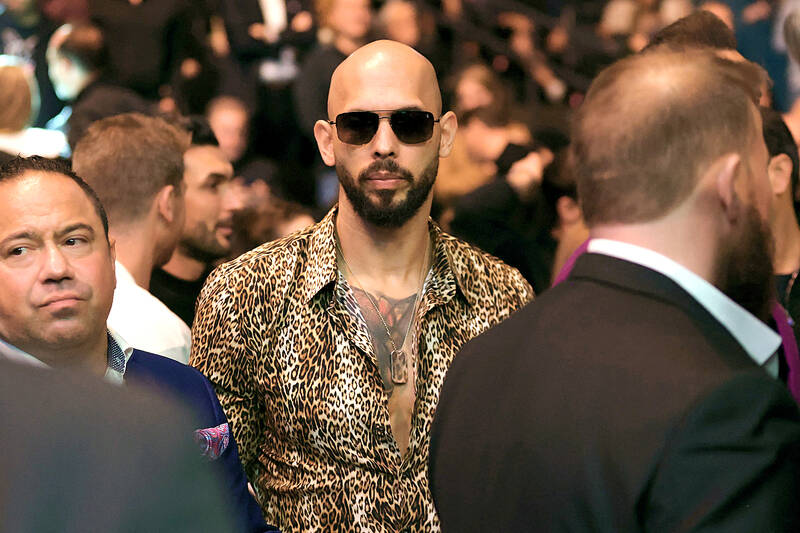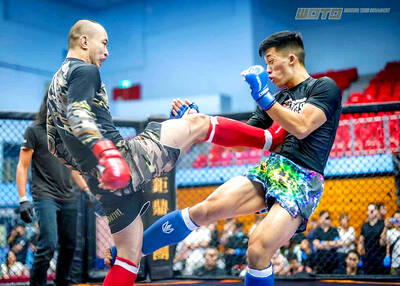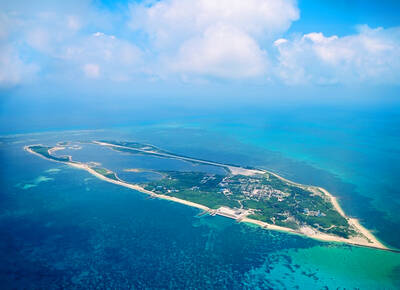Toxic masculinity peddled by online influencers is becoming increasingly prominent, experts say, buoyed by the resurgence of far-right ideology and a virulent backlash against feminism.
In March, a 26-year-old man was jailed in the UK for killing his ex-girlfriend, her sister and her mother with a crossbow and knife last year. Kyle Clifford’s trial heard that he had watched videos by self-proclaimed misogynistic influencer Andrew Tate hours before the horrific murders.
Tate has more than 10 million followers on X and is popular with young men on the platform, where he shares his violent vision of masculinity.

Photo: AFP
While Tate was banned on Instagram and TikTok for his misogynistic tirades, his X account was restored by Elon Musk when the billionaire bought the platform in 2022.
Now, the British-American figurehead of the online masculinist movement has left Romania for the US with his brother Tristan, despite facing rape and human trafficking charges in Bucharest.
The two brothers, outspoken supporters of US President Donald Trump, are now in Florida, where a criminal investigation has been opened against them.
According to Jacob Johanssen, associate professor of communications at St Mary’s University in London, there has been “a normalization of misogyny, rape culture and violence against women and girls.”
The rise of the so-called “manosphere” — made up of online forums and communities that promote masculinism and misogyny — is “intrinsically linked to the growth of right-wing populism across many parts of the world”, Johanssen said.
MEN ‘ALIENATED’
With Trump’s offensive against diversity and inclusion policies, hailed by hard-right politicians in several countries, “anti-woke” rhetoric is gaining ground.
In January, Meta founder and CEO Mark Zuckerberg called for a return to “masculine energy.”
“What we’re seeing is a new dynamic,” said Joshua Thorburn, a doctoral candidate at Australia’s Monash University researching online misogyny, adding that there is now “more visibility” for such ideas.
While some feminist researchers have long warned of an impending conservative backlash against advances in women’s rights, experts point to a crisis in masculinity.
“We live in an unstable and precarious world and men, as well as everyone else, face many problems today. They feel alienated,” according to Johanssen.
This, experts say, is where the manosphere comes in, with its online forums and YouTube channels.
“The different communities in the manosphere function like self-help groups for men where they can discuss issues such as mental health, vulnerability or loneliness,” Johanssen said. “But at the same time, those spaces also contain very toxic discussions of misogyny and sexism.”
‘TRICKING’ YOUNG MEN
According to Thorburn, a large section of manosphere content also “relates to things a lot of young men may be looking for online, such as dating advice, health and fitness advice and financial advice.”
“A young man or teenager may not be explicitly searching for misogynistic content when they first encounter a manosphere influencer’s content or a manosphere community,” he said.
A 15-year-old Londoner called Alistair said he enjoys this kind of content. He is a fan of the YouTube channel and podcast FreshandFit, which describes itself as dedicated to “men’s self-improvement.”
However, in addition to videos on how to achieve dream muscles, other segments discuss why “women are so hypocritical” or why men and women “could never be equal.”
Alistair, who is also a fan of Andrew Tate, does not see any issue.
“It’s about sport and how to make it in life,” the secondary school pupil said. “Where’s the harm?”
In recent weeks, the British television series Adolescence has won praise for its exploration of the subject through the story of a 13-year-old boy who murders a schoolgirl, influenced by online misogyny.
The screenwriters said they were inspired by several real-life events and hoped the show could help audiences understand how boys and young men are influenced by the manosphere.
In a speech on Wednesday, former England football manager Gareth Southgate slammed “toxic” influencers who “trick young men into believing that success is measured by money or dominance... and that the world, including women, is against them.”

Late last month Philippines Foreign Affairs Secretary Theresa Lazaro told the Philippine Senate that the nation has sufficient funds to evacuate the nearly 170,000 Filipino residents in Taiwan, 84 percent of whom are migrant workers, in the event of war. Agencies have been exploring evacuation scenarios since early this year, she said. She also observed that since the Philippines has only limited ships, the government is consulting security agencies for alternatives. Filipinos are a distant third in overall migrant worker population. Indonesia has over 248,000 workers, followed by roughly 240,000 Vietnamese. It should be noted that there are another 170,000

Enter the Dragon 13 will bring Taiwan’s first taste of Dirty Boxing Sunday at Taipei Gymnasium, one highlight of a mixed-rules card blending new formats with traditional MMA. The undercard starts at 10:30am, with the main card beginning at 4pm. Tickets are NT$1,200. Dirty Boxing is a US-born ruleset popularized by fighters Mike Perry and Jon Jones as an alternative to boxing. The format has gained traction overseas, with its inaugural championship streamed free to millions on YouTube, Facebook and Instagram. Taiwan’s version allows punches and elbows with clinch striking, but bans kicks, knees and takedowns. The rules are stricter than the

“Far from being a rock or island … it turns out that the best metaphor to describe the human body is ‘sponge.’ We’re permeable,” write Rick Smith and Bruce Lourie in their book Slow Death By Rubber Duck: The Secret Danger of Everyday Things. While the permeability of our cells is key to being alive, it also means we absorb more potentially harmful substances than we realize. Studies have found a number of chemical residues in human breast milk, urine and water systems. Many of them are endocrine disruptors, which can interfere with the body’s natural hormones. “They can mimic, block

Pratas Island, or Dongsha (東沙群島) had lain off the southern coast of China for thousands of years with no one claiming it until 1908, when a Japanese merchant set up a facility there to harvest guano. The Americans, then overlords of the Philippines, disturbed to learn of Japanese expansion so close to their colony, alerted the Manchu (Qing) government. That same year the British government asked the Manchus who owned the island, which prompted the Manchu government to make a claim, according to South China Sea expert Bill Hayton. In 1909 the government of Guangdong finally got around to sending